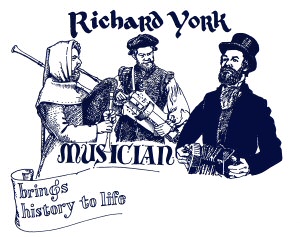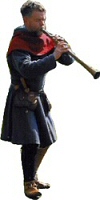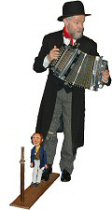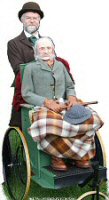 |
 |

|

|

|

|
Medieval Harp for Sale19 string "Gaelic" wire-strung harp by Tim Hobrough
An excellent opportunity to own a decent small wire strung harp, suitable for re-enactment of medieval period, or for practising the skills of wire-string playing without spending out too painfully. The MakerTim Hobrough is famed for making beautiful harps, played by top early harp professionals. He described this harp to me as a prototype, which is why it's astonishingly cheap for a Hobrough harp.Construction
Sound clipsHere are three mp3 files to give some idea of sound. They were not recorded in studio conditions. Ja Nuns Hons Pris, by King Richard I Two voice "Ductia" parts I & II(Quote marks here because that's only the name ascribed to this untitled piece) Bransle Charlotte from "Orchesographie" OverallIt's a very friendly little harp at about a quarter of the price of the best-known worthwhile small wire-strung harps.I bought this harp in the early 1990's when starting my work on heritage sites, and first learning to play clarsach. It's ideal for playing in a quiet chamber, or in a tent, which is entirely period-appropriate for the way such a harp would have been used. The tone is quiet, so not suited to noisy outside settings; but it still has that magical ring of wire strings, quite diferent to gut strung harps, and is surprisingly carrying. Its first gig was out of doors on English Heritage's Middleham Castle, where I was gratified by how well the audience told me it did carry! Its 19 strings are quite enough for a good range of medieval or early celtic music; it's also great for sitting quietly and doodling with - very calming and therapeutic! It's additionally suited to insomniacs, being quiet enough to play without disturbing others in the house, (or if ill, light enough to rest on the chest while lying in bed in the dark...!) Like all wire-strung harps it needs certain skill in tuning, and again in common with its family it likes the shade far more than the sunshine. While wire strung harps were made in Scotland and Ireland, with evidence from at least 1000 years ago, it's also known that Gaelic harpers went on the crusades with their lords; later, when King James came to England as James I, he brought his harper with him. It's always seemed to me perfectly reasonable to play a whole range of period tunes from various places on the wire strings, and many medieval tunes respond thoroughly well to this. Location and PriceThe harp is currently in Northampton, and I would expect you to want to meet it before buying. The expected price is 235 pounds sterling.
Please copy this address, richard at richard hyphen york dot co dot uk, into your usual email form. Happy looking! |